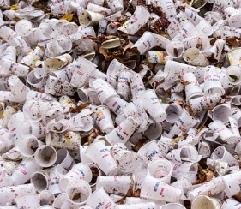Types of pollutants
The classification of pollutant on the basis of their origin
- Primary pollutant
- Secondary pollutant
Primary pollutant:
- These are those which after their formation enter the environment and remain as such.Example: nitrogen and oxygen gas become a pollutant if in excess amount and lead to harmful effect like cause of acid rain etc.
Secondary pollutant:
- These are harmful materials that are formed by chemical reactions between primary pollutants in atmosphere or hydrosphere
Example: hydrocarbons and oxides of nitrogen react in presence of sunlight to form compounds like PAN .so PAN is secondary pollutant as it is formed by reaction between primary pollutants.
Another classification of pollutants: on the basis of their degradation
- Biodegradable
- Non-biodegradable
Biodegradable: are materials that are decomposed by microorganisms either by themselves or by microorganisms.

Example: domestic sewage, cow dung etc.
Non-biodegradable:
Theseare materials that are not decomposed by either by itself or by microorganisms and their presence in environment leads to pollution. They may be a raw material for producing other toxic substances.
Example: plastics etc.
